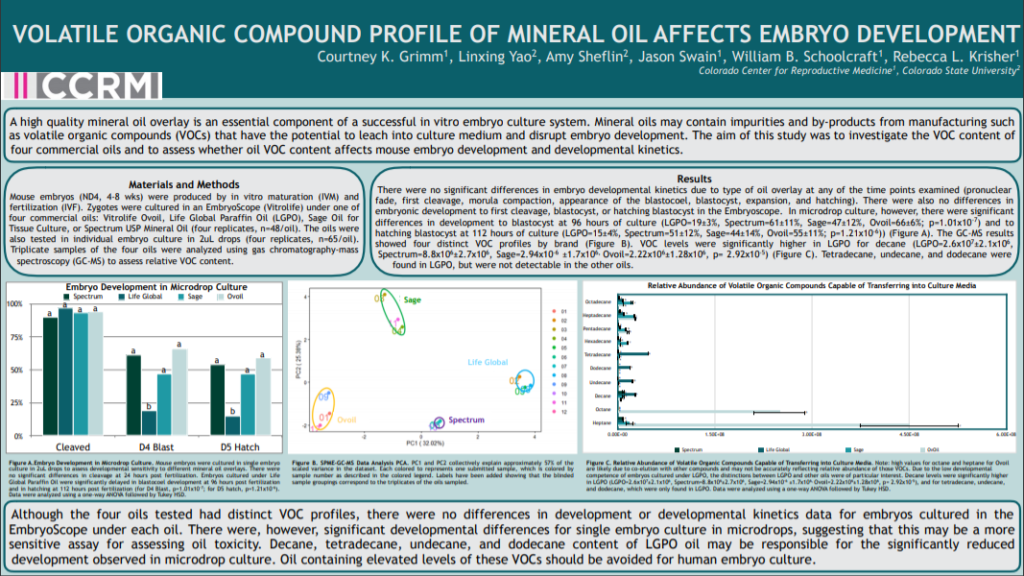Track: ART – LAB
Poster : ART Lab: Basic
Courtney K. Grimm
Network QC Manager
CCRM Colorado
Lone Tree, Colorado
Objective: A high quality mineral oil overlay is an essential component of a successful in vitro embryo culture system. Mineral oils may contain impurities and by-products from manufacturing such as volatile organic compounds (VOCs) that have the potential to leach into culture medium and disrupt embryo development. The aim of this study was to investigate the VOC content of four commercial oils, and to assess whether oil VOC content affects mouse embryo development and developmental kinetics. DESIGN: Research study MATERIALS AND
Methods: Mouse embryos (ND4, 4-8 wks) were produced by in vitro maturation (IVM) and fertilization (IVF). Zygotes were cultured in an EmbryoScope (Vitrolife) under one of four commercial oils: Vitrolife Ovoil, Life Global Paraffin Oil (LGPO), Sage Oil for Tissue Culture, or Spectrum USP Mineral Oil (four replicates, n=48/oil). Spectrum and LGPO were also tested in individual embryo culture in 2uL drops (four replicates, n=69 and 67, respectively). Triplicate samples of the four oils were analyzed using gas chromatography-mass spectroscopy (GC-MS) to assess relative VOC content.
Results: There were no significant differences in embryo developmental kinetics due to type of oil overlay at any of the time points examined (pronuclear fade, first cleavage, morula compaction, appearance of the blastocoel, blastocyst, expansion, and hatching). There were also no differences in embryonic development to first cleavage, blastocyst, or hatching blastocyst in the Embryoscope. In microdrop culture, however, there were significant differences in development to blastocyst at 96 hours of culture (LGPO=13±6%, Spectrum=65.6±26%; p=0.028) and to hatching blastocyst at 112 hours of culture (LGPO=7.8±9.7%, Spectrum=50±27%, p=0.045). The GC-MS results showed four distinct VOC profiles by brand. VOC levels were significantly higher in LGPO for heptadecane (LGPO=9.8×106 ±2.9×106, Spectrum=2.8×106±1×105; p=0.0288) and for decane (LGPO=2.6×107±2.1×106, Spectrum=8.8×106±2.7×106, p=0.00013). Tetradecane, undecane, and dodecane were found in LGPO but were not detectable in Spectrum.
Conclusions: Although the four oils tested had distinct VOC profiles, there were no differences in development or developmental kinetics data for embryos cultured in the EmbryoScope under each oil. There were, however, significant developmental differences for single embryo culture in microdrops under LGPO and Spectrum oils, suggesting that this may be a more sensitive assay for assessing oil toxicity. Heptadecane, decane, tetradecane, undecane, and dodecane content of LGPO oil may be responsible for the significantly reduced development observed in microdrop culture. Oil containing elevated levels of these VOCs should be avoided for human embryo culture.
ASMR official sponsorship in the publications of the virtual ASMR conference October 17-21 October 2020

